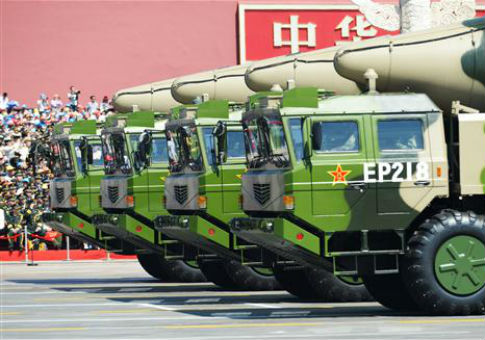China, Russia, and rogue states like Iran are investing in advanced missile technology that will threaten the United States.
The Obama administration’s defense policy has lagged in the field of missile deterrence, according to a new study from the Hudson Institute prepared with input from former officials and military leaders.
Increasing shortcomings in U.S. preparedness has encouraged other nations to prioritize development of missiles that threaten U.S. interests at home, abroad, and in space.
Competitive powers like China and Russia have put significant resources toward developing anti-ship missiles, hypersonic glide vehicles, and other complex systems while the U.S. has continued to rely on limited missile deterrence. Rogue states like Iran and North Korea also have made gains in missile technology development and proliferation.
"Countries like China, like Russia, like North Korea and Iran have been devoting a tremendous amount of resources to denying our access to space as well as providing their own capabilities to take advantage of it offensively," former Senate Minority Whip Jon Kyl (R., Ariz.) said in Washington, D.C. on Wednesday, standing alongside Sen. Tom Cotton (R., Ark.) and retired Army Gen. Charles Jacoby, the former commander of U.S. Northern Command, at an event promoting the study.
The Obama administration has limited its defense systems to avoid upsetting China and Russia. "We have made clear both in our policy and in the capabilities we have deployed that our homeland defense is not intended to affect the strategic balance with Russia and China," said Frank Rose, the assistant secretary for the bureau of arms control, verification, and compliance at the State Department, during remarks at a missile defense conference in June 2015.
The Hudson Institute study finds that this approach has encouraged competition, inciting adversaries to pursue weapons that can target U.S. vulnerabilities.
"It’s impossible to say that it’s provocative to develop defensive capabilities to protect your own people," said Cotton, a member of the Senate Armed Services Committee. "Our forbearance for all these years has gotten us nothing but greater vulnerabilities."
The technological advances of these nations pose a particular challenge to U.S. space systems. Both China and Russia have tested anti-satellite missiles—Russia as recently as May—and prioritized their space weapons programs. Without proper countermeasures, these missiles could destroy U.S. satellites.
"We’ve become very reliant in some of our most important functions in warfighting, and in the economy, and in entertainment and how we live, very reliant on space-based technologies," Jacoby said Wednesday. "Now we have to face reality, and because we are so reliant on them. In many ways, space-based systems have become a center of gravity for us in different functions of command and control. You can’t leave this to chance and vulnerability."
Iran and North Korea have also tested and developed ballistic missiles in defiance of international sanctions, and have used their space programs to advance their missile programs. One of the primary concessions the United States offered Iran in the nuclear deal finalized one year ago was relaxed restrictions on Tehran’s missile program.
In order to close capability gaps in space, the study recommends the United States invest more in missile defense technology. It also recommends developing a space-based interceptor to complement land- and sea-based interceptors that make up the military’s ballistic missile defense system.
This technology would take 10 years to develop, according to one estimate, and would cost between $26 billion and $30 billion.
"[A space-based interceptor] capability would dramatically augment U.S. terrestrial- and sea-based defensive capabilities, reduce the demands upon current systems, and provide the United States with the optimal vantage point for destroying enemy missiles regardless of their launch or target location, whether on land, at sea, in the air, or in space," the report states. "A critical benefit of [a space-based interceptor] layer is the ability to destroy many missiles during their boost phase, while the missile is still over enemy territory and before the enemy can deploy their nuclear warheads, counter- measures, and decoys."
The George W. Bush administration unsuccessfully pushed Congress to begin funding a space-based interceptor program, in addition to other plans to bolster missile defenses in Europe. The Obama administration scaled back the Europe efforts, even as tensions with Russia have escalated to levels not seen since the Cold War.
Lawmakers have sought to boost missile defense through provisions included in annual defense legislation for the next fiscal year, though the president has threatened to veto the bills.
The report also makes the case for the U.S. Strategic Command to conduct "space force application" missions, or combat operations in and from space. This goal would require the United States to overcome limits on the scope and technical ability of its missile defense policy.
"Remaining vulnerable to current missile threats is to knowingly place the security of Americans and the United States’ military pre-eminence at the mercy of countries like China, Russia, North Korea, and Iran. This is highly unstable, and because it is technically avoidable, wholly unacceptable," the study concludes.
The study’s senior review group included a number of prominent former officials and military leaders, including Jacoby and Kyl, as well as former Undersecretary of Defense for Policy Eric Edelman, former NASA administrator Michael Griffin, and retired Air Force Lt. Gen. Henry Obering, former director of the Missile Defense Agency.
